#quezon city based
Explore tagged Tumblr posts
Text

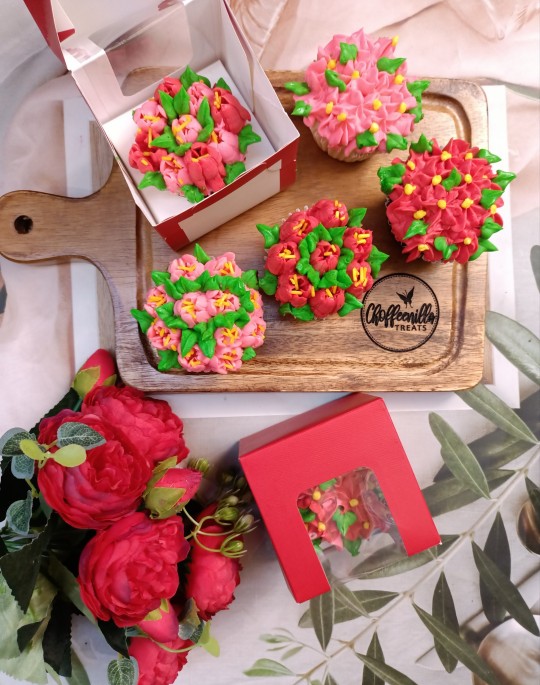
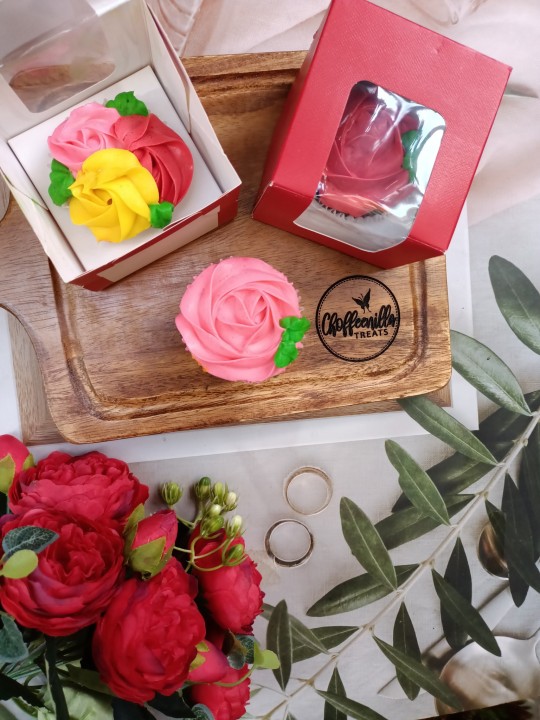

Valentine's 2024 cupcakes ❤️ 🧁 🌹
#dessert#cupcakes#valentines day#valentines 2024#valentines philippines#valentines ph#cupcakesph#quezon city#quezon city based#metro manila#metro manila based#philippines#valentines gifts#valentines gift ideas#choffeenillatreats
3 notes
·
View notes
Text




PROTECT ENVER AT ALL COSTS
📍 Lucena City, Quezon Province, Philippines
We can't help but post this because we are deeply angered by what happened to Enver!
In the first week of January 2025, we found Enver injured and bleeding. Based on his condition, it seemed that someone struck his leg, causing continuous bleeding and difficulty walking.
Our priority was to ensure his safety and get him treated, which is why we did not immediately post about the incident. We were afraid that posting right away might provoke further harm to Enver.
After weeks of treatment and care, Enver is now fully recovered and lively again. However, we are taking this opportunity to ask for help from fellow Fur Parents here in University Village, Lucena City as well as the students in the area. Please help us protect not just Enver but also the other Montevideo Dogs, Community Dogs and Cats in the village. If you witness or see anyone harming them, please immediately take photos or videos to serve as evidence. This will allow us to approach the proper authorities and hold the perpetrators accountable.
Unfortunately, we have no evidence of who hurt Enver. We have our suspicions, but suspicions alone are not enough to bring justice. That is why we are reaching out to all of you...
PROTECT ENVER AT ALL COSTS! 💛 HELP US TO PROTECT MONTEVIDEO DOGS! 💚 HELP US TO PROTECT THE COMMUNITY CATS AND DOGS! 🧡 NO TO ANIMAL CRUELTY 🙅🏼
⚠️ ENVER IS VACCINATED AGAINST RABIES. We have his vaccination card, so regardless of any reason the perpetrator may have, what they did is absolutely unacceptable. 😡
#CatsOfQuezonProvince#CoQP#CoQPTheStoryOfUs#SlowDownForPaws#PetsAreNotGifts#NoPetsLeftBehind#KaponAngSagotHindiPound#AdoptToSaveAndChangeTheirLives#AdoptPuspinsToSaveAndChangeTheirLives#KaponAngSolusyonParaPopulasyonNgPuspinAyMakontrol#SponsorAKaponAndSavePuspinLives#Cat#Cats#Dog#Dogs#Puspin#Puspins#Aspin#Aspins#CatLovers#DogLovers#AdoptACat#AdoptADog#AdoptAPuspin#AdoptAAspin#CatsOfPH#DogsOfPH#cats of the internet#cats of tumblr
4 notes
·
View notes
Note
What is Backtrack about?
Ohohoho I already have a thing lined up to introduce my characters.. I guess I can spill the caption
For over a decade, a string of crimes based in a highschool in Parañaque City has remained unsolved. Twelve years later, a suspect in the case was murdered in the same manner as the previous victims. Samantha Eusebio, a private investigator, has been hired to revisit the crime that she had been accused of all those years ago.
It’s a murder mystery type of story based in the Philippines, mostly the northern NCR area (Makati, Manila, Quezon City).

Because I feel nice, here is my favorite suspect, Homer Sabio. He’s a journalist first and foremost, but he’s also a model and actor for the most well known broadcasting channel in the country <33 my child
4 notes
·
View notes
Text

Working on BlightBlur Hoenn w friends to make it seem more like the PH (considering that's the biggest worldbuilding change for Pokemon Blight/Blur), and we've worked on a couple of things. :) 👍 Areas have been marked based on their inspirations off of the Philippines' three major islands; Luzon (red), Visayas (blue), and Mindanao (yellow).
Cities/towns take inspiration from actual places- we're currently working on them, but so far;
Dewford Town - Represents all of Mindoro, specifically, Oriental Mindoro.
Mauville City - Represents all of Metro Manila, particularly City of Manila; especially Intramuros. Due to how Mauville City looks in the remake (a walled area in the City of Manila), it's a mix of the structure of Intramuros, with the modernization and aesthetics of other cities in Metro Manila, like Quezon City.
Verdanturf Town - Province of Laguna
Mossdeep City - Represents the Davao region
Sootopolis City - Province of Cebu
Still a WIP, but other ideas so far are;
Fallarbor or Lavaridge as Bicol, Slateport as Batangas, and Rustboro as either Cavite or Antipolo. Also, these are not entirely accurate to the PH geography . We are mostly going based off what the towns/cities are in canon .
5 notes
·
View notes
Text
bbc ghosts but they’re all Creatures™ from Philippine mythology
*the english translation of the filipino terms are boldly formatted
**i’m not an expert on this area, i just loosely describe and relate the characters based on what i know
**blood, guts, gore, and horror in general ahead, the illustrations are also not mine
• Kitty - diwata or boringkantada or a duwende
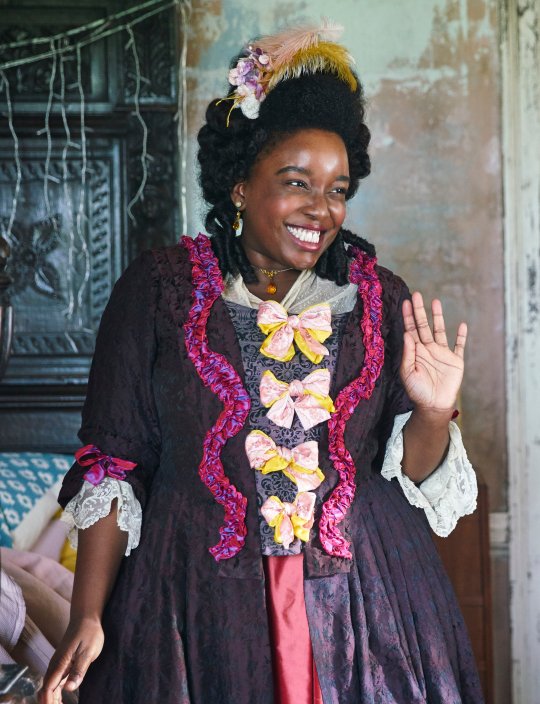

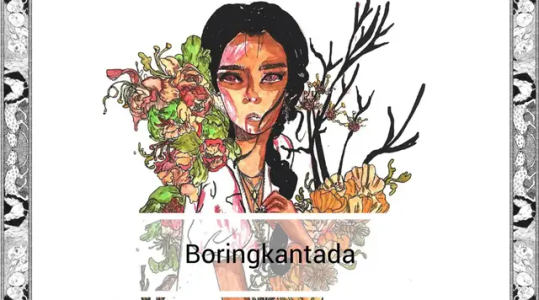
can’t decide which works best for kitty: a filipino nymph, a beautiful supernatural woman or a playful hobgoblin.
diwata is umbrella term for beautiful goddesses, and the most popular ones are dayang makiling, mariang sinukuan, and maria cacao. i think kitty would be mariang sinukuan— a kind and generous goddess who stopped bringing fruits and harvests to humans when they became unsatisfied and greedy.
a boringkantada is definitely not boring: it possesses beauty both physically and in its voice. when someone is lured by its singing, it instinctively assumes the person is about to rob the treasures it guards and viscously attacks them.
the hobgoblin that loves to play, a duwende has the tendency to be extremely jealous and may either shower gifts to the ones they like and play tricks on the ones they don’t.
*i also see pat as a duwende, and i’ll elaborate that on the next parts.
• Fanny - white lady or a dalikamata

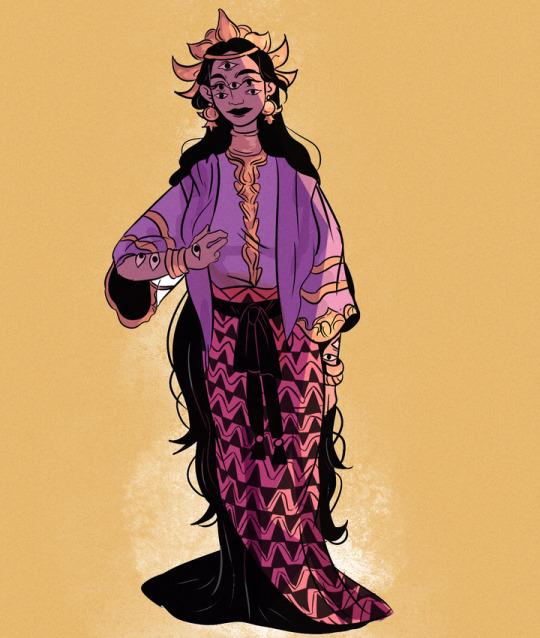
i mean, she’s already a grey lady so this one’s not far-fetched. basically, a white lady is a ghost dressed in a white dress, particularly an urban legend that resides in a Balete tree in Quezon City, Manila. it is also known as the Weeping Woman or the Wronged Woman in other beliefs.
alternatively, i also think she would be a dalikamata— a Visayan goddess with many eyes that can see the past, present and the future. i relate the all-seeing, all-knowing attribute to fanny’s nosy attitude.
• Mary - albularyo
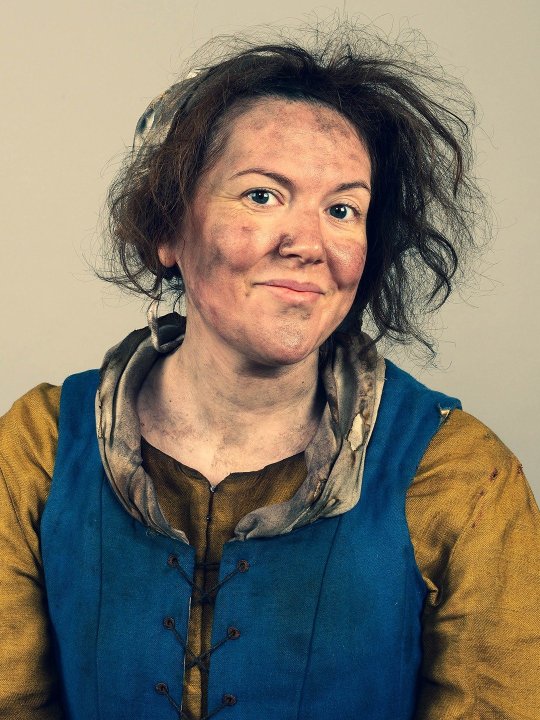

derived from the spanish term herbolario, these folk or witch doctors are either believed to have supernatural abilities to cure illness better than modern medicine or hated for being a pseudoscience and/or a witch. screams mary to me. She knows every herb and ointment, can track the roots of what caused the sickness, but also has the capability to harm those who wronged her. ultimately, she does her best to help others.
• Annie - mangkukulam
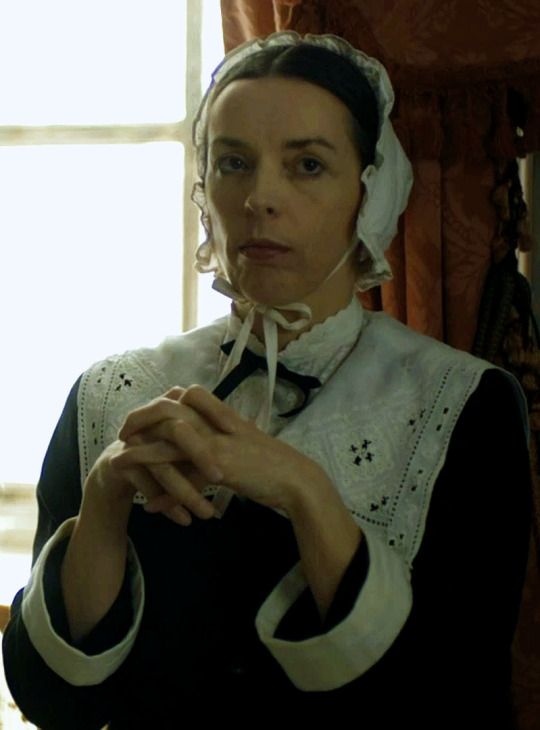

rip annie you would’ve loved putting curses on men. she would’ve been a powerful witch. there are many other terms for filipino witches according to respective regions, but we call them mangkukulam in our area. plus, these witches believe that their spells do not work on the innocent, their targets often being thieves and colonizers.
side note: i actually have this oc from a story i once tried to write wherein the albularyo and mangkukulam are girlfriends because of the contradicting capabilities, and the idiots themselves told me mary and annie were gay.
• Pat - nuno sa punso or a duwende


a nuno sa punso is a dwarf goblin that will harm you if you anger it by kicking its house (an anthill) and/or pissing on it. if modern medicine cannot cure you in any way and you have disrespected him, you may need to ask for his forgiveness or seek help from the albularyo. “tabi-tabi po” or “excuse me please” is a phrase you say to show respect to beings like this.
my first reason for nuno!pat was because of his height. but it is also depicted as a tiny, angry grandpa and a protector of the earth— which reminds me of pat.
on the other hand, the duwende is a hobgoblin that likes playing with children because of its natural playful attitude. this one’s not that easily angered unlike the nuno sa punso, but can still hurt those it doesn’t like.
• Captain - kapre

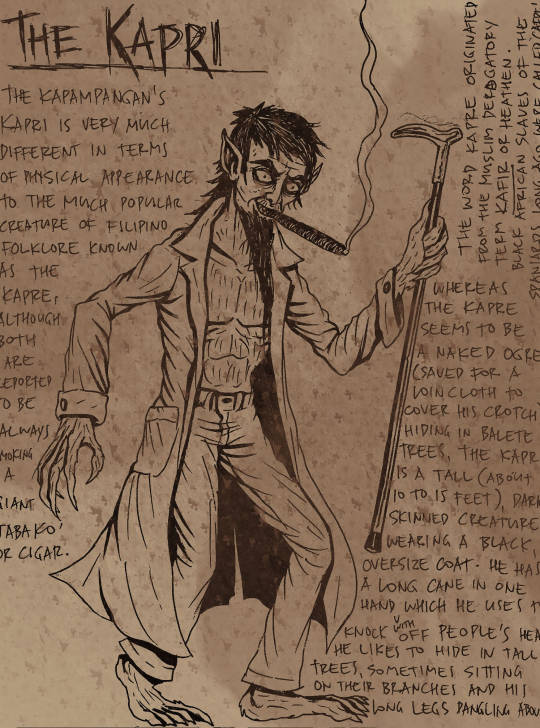
the way i giggled when i thought of cap being a CAPre. kapre cap,,, i feel like the funniest person alive. the photo makes it funnier— just some local kapre with glasses with a tree behind it
a kapre is a cigar-smoking, tree-dweller. traditionally, it presents itself as a hairy, muscular, and tall guardian/protector of the land that can also shapeshift into a beautiful man to invite people to follow them (especially in the woods). hence, it can make you run around in circles as you forget memories of your life.
side note: thomas can also be a kapre because if a kapre likes you, it will follow and protect you from your enemies for life. a former filipino president (emilio aguinaldo) is believed to have outlived his enemies because he had a kapre amulet.
• Humphrey - manananggal or pugot

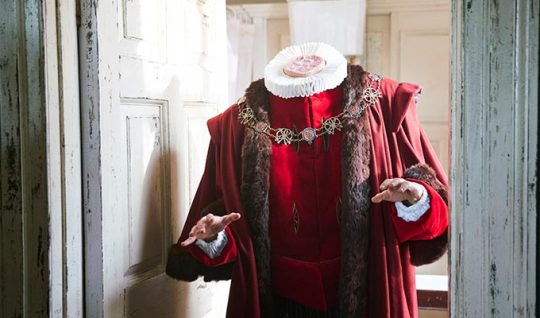

a manananggal is a self-segmenting vampire. its upper torso has wings that help it fly and hunt humans (particularly pregnant women and their babies), while its lower torso stays behind. there is a belief that you can actually kill it by finding its lower torso and putting salt or crushed garlic in it in order to prevent it from uniting with its upper torso. i’m thinking about this image of humphrey’s head having wings attached behind him, and his tudor outfit already spells out vampire to me.
or if we’re gonna be canon compliant, humphrey is already a version of a pugot— a headless creature from the ifugao. but i’m putting this on a maybe part because there are many versions of the pugot: some believe it is a version of the kapre, some believe it is a shapeshifting ghoul.
• Robin - aswang or sigbin or bungisngis



aswang is a broad, umbrella term for all cannibal shapeshifters. they appear as normal humans by day, and various human-animal hybrids by night.
i also see robin as a sigbin. both are seen as dog-like creatures that eat fresh, bloody, and raw meat. some believe that you can keep a sigbin as a pet that will protect you and even let you hop in on its back— but once you let it starve, it will always be a creature of the night that can eat you and your entire family.
robin would also make a good bungisngis because it is a cannibal one-eyed cyclops. its name directly translates to “one who giggles a lot”, which is why it is known for laughing and playing tricks. ironically, it is dumb enough to be tricked.
• Julian - bakunawa or engkanto


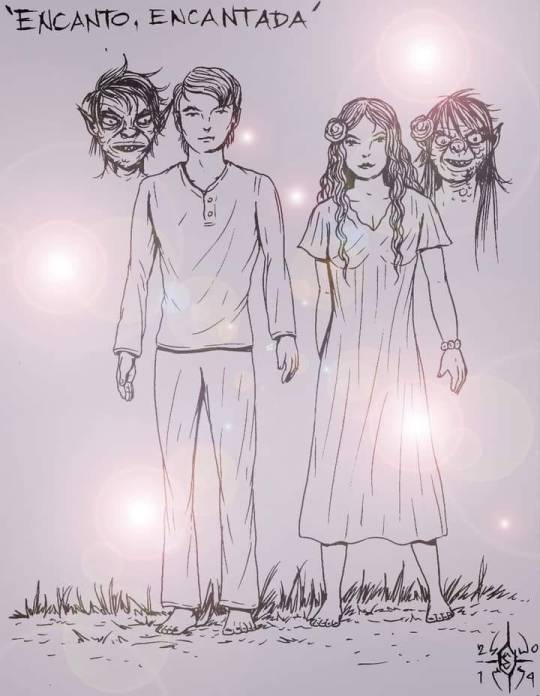
the bakunawa is a dragon serpent notably known for allegedly eating the earth’s seven moons. i’d like to think of that as a parallel to a politician like julian being enamored by the shiny power and wealth.
and because of julian’s charms, he would also be an engkanto— environmental spirits that presents to be good-looking and formerly known as a protector of the people but may also tend to be deceiving (much like of a politician).
• Thomas - tikbalang


this one’s peer-reviewed by a friend so i’m more than confident about thomas being a tikbalang. it appears to be a half-human half-horse creature known to lead travelers astray as they live in the mountains. it is known to be mischievous when it play tricks on humans (a tribute i might also relate to julian or robin), so make sure to wear your shirt inside out or stay quiet while in the woods to not disturb it.
unrelated but fun fact: if it’s raining, we have this belief that a tikbalang is getting married. (this phrase is potentially from the spanish when they believed that a witch is getting married when there’s rain on a sunny day)
#bbc ghosts#button house#six idiots#them there#tw blood#tw body gore#dakotasvibe#userligaya#alison obviously has a third eye#and mike would be the type to be very superstitious#he’d have salt and garlic ready#as you can probably tell#i’m very Normal about this#i’m very tempted to make this a gifset
19 notes
·
View notes
Text
UPIS holds first BSP & GSP investiture since pandemic
The University of the Philippines Integrated School (UPIS) recently held its first investiture and camp since the pandemic, officially ushering in new members of the Boy Scouts of the Philippines (BSP) and Girl Scouts of the Philippines (GSP). The BSP held their investiture in the 3-6 Bulwagan on March 1, while the GSP had theirs in the 7-12 Gym on March 8.
Boy Scouts from Grades 3-6 and Senior Scouts from Grades 7-10, along with their club advisers, selected faculty, and former Senior Scouts, organized the BSP investiture and camp. The investiture ceremony included the acceptance of the new members of the BSP, oath-taking, and the Paglagay ng Alampay where the scouting neckerchief is worn to symbolize their official recognition as Boy Scouts. A message was also delivered by the second-in-command of the Quezon City BSP Council, Asst. Chief Scout Executive Amado Dela Cruz. After the investiture, a bonfire was also done.
According to Mr. Joseph Guiao, adviser of the Senior Scouts, adjustments were made in the scouts’ schedule due to the pandemic, and the investiture was pushed back to the second semester as the organization needed to familiarize itself first with the procedures and preparations necessary for their activities.
“Due to the pandemic, the Phoenix in UPIS didn't have a proper “passing of the torch”.. We, current Phoenixes were lucky we got to go to the World Scout Jamboree in Korea to make up for our lack of experience. In relation to that, we didn't really have much experience in planning an event such as the investiture, but the investiture was still a success thanks to kuya Raymond (former Senior Scout) guiding us through the formalities,” said Troy Dela Torre, one of the six leaders or Phoenixes of the club.
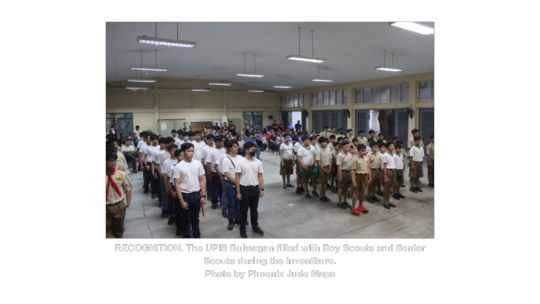
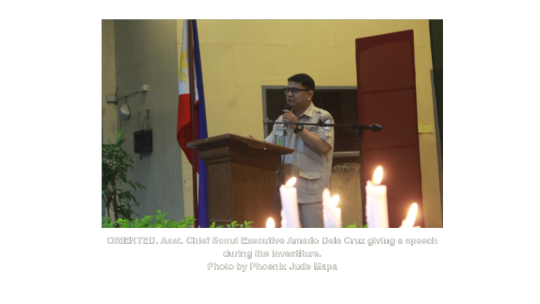
On the other hand, it is the first time the Junior and Senior Scouts of GSP held a joint investiture with the Star Scouts from Grade 3. This was due to the PUV transport strike last December 2023 which delayed the original date of both the Star and Senior Scouts’ investiture, moving it to March this year.
The GSP investiture program was organized by the advisers and co-advisers of the Star, Junior, and Senior Scouts. The program was executed as follows: recitation of the Law and Promise of the Star Scouts, appointment of the new Junior and Senior GSP, including the Cadets and Troop leaders, followed by the donning of pins and the alampay by the Troop Leaders and parents, respectively. After the investiture, a one-day camp was held. This included the Bravery Test (Senior Scouts only), Base Method, Flag Making and Presentation, Awarding Ceremony, and many more.
“Ngayon, naki-join din ang Grade 3 Star Scouts na may ibang program; parang iba yung flow nila. So ang challenge ay paano i-integrate yung dalawang program na ‘yon para maging isa lang at walang mawawalang importanteng mga parts ng flow ng program,” stated the adviser of the GSP, Asst. Prof. Portia Dimabuyu, on the challenges in the change of the program due the joint investiture.
“We had 2-3 days of practice in the gym. Since we didn't have enough time to practice and plan, the Star Scouts were included in the investiture of the Senior Scouts so the flow of the program was longer and kind of messy,” added Corinne Juliette Hernandez, the head Cadet.
Prior to the pandemic, participation in the GSP was not mandatory for Grades 11 and 12 as clubs were typically limited up to Grade 10. However, there arose a necessity for experienced Senior Cadets to assist and guide the newly enrolled Scouts and Cadets.
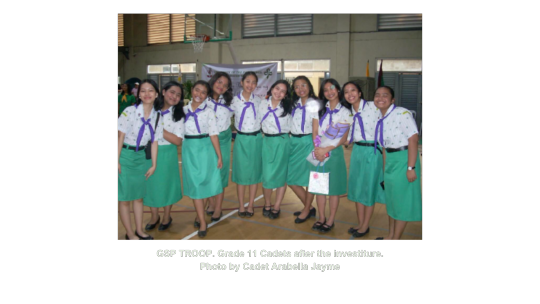
Both the BSP and GSP investiture and camp required careful preparation, from arranging the venue and getting the necessary camping permits. Prior to the event, the Scouts were registered with the Quezon City Council. Briefings and practices were also conducted to ensure the smooth flow of the program.
The pandemic greatly impacted the BSP and GSP, resulting in a lack of experience among members and leader scouts. Nonetheless, the investiture and camp were still a success, thanks to the guidance of advisers and former Senior Scouts who made sure to help the new Scouts become official members of the UPIS BSP and GSP.
//nina KC Dela Cruz, Faye Obaña, and Aisha Timbal
4 notes
·
View notes
Text
On Being an Introvert in the Philippines

Introduction
Exploring the lively and social culture of the Philippines as an introvert can be challenging and complex. In a country where family and community are largely valued, introverts frequently find themselves going against the societal norm. Let's delve into the distinct difficulties and challenges faced by introverts in the Philippines, including my own experiences.
Understanding Collectivism in the Philippines' Culture
Collectivism is deeply wired in Filipino culture, where the norm favors groups, family, and community over an individual. For example, Filipinos frequently seek guidance and advice from their families when making significant life decisions like career choices or marriage. Family and community play an important part in Filipino society, with major life decisions generally involving the entire family, including the extended family. The culture of having an extended family living together and helping and supporting each other in their day-to-day lives is also prevalent.
The Challenges of Family and Social Gatherings
As a kid, I recall how family gatherings were a regular thing to do when there would be an occasion, such as attending family reunions during fiestas in the province. While I respected the close-knit nature of Filipino families, these gatherings would often be an exchange of communications among relatives. The anticipation to interact with them would be draining for an introvert. Filipinos value social harmony and tend to avoid conflicts and confrontations. It's common for individuals to maintain polite interactions by abstaining from expressing disagreement when they hold differing opinions during family gatherings.
The Impact of Barrio Fiestas and Religion
Barrio fiestas in the Philippines are significant community fests. These occasions emphasize community involvement and social relations, which can be a draining activity for an introvert due to the crowds and nonstop socializing. Religion also plays a part in adding to the collectivist culture of the Philippines, with the majority of the population being Catholic. Religious values often affect the significance of community, family, and social harmony.
The Extroverted Nature of Filipino Culture
In the Philippines, being sociable is the norm. Striking up conversations with people in public places like markets or public transportation is common, as is befriending people and having a group of friends. This can be surprising for an introvert who prefers solitude. Introverts in the Philippines may feel pressured to engage in social events regularly, leading to exhaustion. The extroverted culture can overshadow the contributions of introverts, making them feel misunderstood and undervalued.
Personal Experiences and Educational Challenges
Personally, I have often been criticized for being quiet, labeled as a "snob" or a "weirdo" by family and acquaintances. In terms of educational settings, curriculums in the country's education comprise group activities, performance-based tasks, recitations, etc. In which introverted students may struggle to thrive, affecting their grades and self-confidence.
Tips for Thriving as an Introvert
For introverts in the Philippines, finding quiet spaces, setting boundaries, and connecting with like-minded individuals can be beneficial. Embracing one's introverted traits and communicating openly about needs can help introverts thrive in an extroverted culture.
Conclusion
Being an introvert in the Philippines comes with its own set of challenges and opportunities for growth. By understanding and appreciating the cultural values of collectivism and social harmony, as well as the extroverted nature of Filipino culture, introverts can navigate their social landscape more effectively. So, embrace your unique traits, set those boundaries, and find your balance—you've got this!
Resources
Cruz, I. J. (2000). Culture and its influence on Filipino psychology. Quezon City: University of the Philippines Press.
Enriquez, V. G. (1994). From colonial to liberation psychology: The Philippine experience.
Manila: De La Salle University Press.Hofstede Insights. (n.d.). Philippines - Country comparison. Retrieved from https://www.hofstede-insights.com/en/countries/philippines/
Lising, R. A. (2018). Understanding Filipino psychology: A guidebook for teachers and students. Manila: Rex Bookstore.
#philippines#culture#introvert#collectivism#extroverted#extrovertedculture#personal experiences#personal experience#educational harmony#social harmony#societal norms#societalnorms#introvert in the Philippines
2 notes
·
View notes
Text
"Hidden Gem Unveiled: Exploring the Beauty of López, Quezon"

Lopez Quezon is one of the provinces that you will surely enjoy. This province also has a lot to offer, such as different fountains, historical sites, and even beaches. In addition, based on my experience, what makes it different from other places is that the life there is low-cost; for instance, the tricycle fare only costs 10 pesos, but when it comes to other places, it costs 50 pesos, even if the distance is almost the same.
Furthermore, when it comes to accommodation in different tourist spots, it is also low-cost, unlike other tourist spots. Such as the hotel, the cost of staying at beaches, and many more. Thus, you will surely grab the opportunity to explore this province.
One of the most visited places in Lopez Quezon is the Lost Villa, a worthy paradise. It is a great place because of the warmth and coziness that would continually remind you of Bali or Siargao, they also claimed that Lost Villa resembles to those islands.
It's been years since I got to travel in this province. Lopez Quezon is 4 hours drive from San Pablo City. Nonetheless, a visit to Lopez Quezon is highly recommended because it is home to a diverse array of sights and experiences.

3 notes
·
View notes
Text





𝙱𝚞𝚝 𝙵𝚒𝚛𝚜𝚝, 𝙲𝚘𝚏𝚏𝚎𝚎 | >
Must try!!! ✨ Super love their coffee and will definitely try the others in the menu. We ordered Iced Caramel Macchiato and Iced Americano (less water, more ice)
They used premium local coffee beans to support our Filipino coffee farmers, however, with the help of their combined technical know-how they still produced a good quality coffee that rivals the best-known coffee brands while remaining reasonably priced that every Filipino may enjoy it. 💗
☕ 100% Arabica beans for Espresso based. Barako beans for Drip based.
☕ Good quality for its price (got mine for 170php and 150php for Americano. It's 500ml in a jar.)
☕ The place is just small but very nice and neat, plus you can have your coffee-to-go anytime or delivered. (they have many branches especially in QC).
☕ The baristas were very welcoming and explained each cup of coffee in a very detailed manner which showed how well trained they are.
Here are their some branches that I already visited:
📍Blk 5, West Fairview Park, 9 Chestnut, Novaliches, Quezon City, Metro Manila
📍88 Congressional Ave, Project 8, Quezon City, 1106 Metro Manila
2 notes
·
View notes
Text
POST EDSA REVOLUTION IN THE PHILIPPINES

Photo edit: https: //pin.it/3OW6izm
The People Power Revolution, also known as the EDSA Revolution, was a series of protests and demonstrations that took place in the Philippines from February 22 to 25, 1986. The revolution was a nonviolent, popular movement that led to the overthrow of the authoritarian regime of President Ferdinand Marcos and the restoration of democracy in the country.
Background
Ferdinand Marcos, a former senator and war hero, became president of the Philippines in 1965. His presidency was characterized by corruption, human rights abuses, and the suppression of opposition groups. Marcos declared martial law in 1972, suspending the constitution and assuming near-dictatorial powers. Under martial law, thousands of Filipinos were arrested, tortured, or killed for their political beliefs. The country's economy suffered as well, with rampant corruption and cronyism leading to widespread poverty and inequality. Opposition to Marcos' regime grew throughout the 1970s and 1980s, as Filipinos became increasingly disillusioned with his leadership. Catholic bishops and priests were particularly vocal in their criticism of the regime, with many speaking out against the violence and repression inflicted upon their parishioners. International pressure on Marcos also mounted, as foreign governments and human rights groups condemned his record on human rights and democracy.
The Revolution
The EDSA Revolution began on February 22, 1986, when a group of military officers led by Defense Minister Juan Ponce Enrile and Lieutenant General Fidel Ramos declared their withdrawal of support from Marcos. The officers set up a makeshift headquarters at the Camp Aguinaldo military base in Quezon City and called on Filipinos to join them in their opposition to the regime.Word of the military rebellion quickly spread throughout the country, and Filipinos began to gather at EDSA, a major highway in Manila, to support the rebels. The protestors, which included ordinary citizens, students, religious groups, and members of the opposition, set up barricades and formed human chains to block government troops from reaching the rebels' stronghold at Camp Aguinaldo.The situation was tense, with the possibility of violence hanging in the air. However, the protestors remained peaceful and determined, singing patriotic songs, praying, and offering food and water to the soldiers stationed at EDSA. The movement grew in strength and numbers over the next few days, with estimates of the crowd ranging from hundreds of thousands to over a million people. The turning point of the revolution came on February 25, when Marcos ordered his troops to disperse the protestors and storm Camp Aguinaldo. However, the soldiers refused to obey his orders, and instead joined the protestors in their call for Marcos to step down. Marcos, sensing that he had lost the support of the military and the people, fled the country with his family on a US military aircraft bound for Hawaii. The EDSA Revolution was a historic moment in Philippine history, marking the end of the Marcos regime and the beginning of a new era of democracy and freedom. Corazon Aquino, the widow of opposition leader Benigno Aquino Jr., was sworn in as president on February 25, 1986, becoming the first female president of the Philippines.
Aftermath
Aquino's presidency was marked by challenges, including a series of coup attempts by loyalists of the Marcos regime, as well as natural disasters and economic problems. However, her government was able to enact important reforms, such as the restoration of civil liberties and the drafting of a new constitution that limited the power of the presidency and strengthened democratic institutions. Today, the EDSA Revolution is celebrated as a symbol of Filipino people power and resilience. It serves as a reminder of the importance of democracy and the struggle for human rights and freedom in the Philippines and around the world.
Reference:
Abihales, P.N., & Amoroso, D.J (2017) state and society in the Philippines. Rowman & little field Publishers.
Mccoy, A.W.(2018). In the shadow of the EDSA Revolution: Democracy and economic crisis in the Philippines. University of Wisconsin Press.
2 notes
·
View notes
Text

Blue vanilla cupcakes are so picture pleasing 💙🥰
#dessert#cupcakes#cupcakesph#cupcakephilippines#blue#vanilla cupcakes#blue cupcakes#choffeenillatreats#metro manila#quezon city#metro manila based#quezon city based
0 notes
Text
Learning from Friends: “The Collective School”
The below conversation was published in e-flux Education on March 30, 2023. Thank you, Tyler Considine, for the invitation.
Asia Art Archive (AAA) in Hong Kong recently hosted “The Collective School,” an exhibition and a program series exploring artist-driven and collective models of learning. Developed in collaboration with Gudskul, a Jakarta-based collective that runs a grassroots school for other collectives, the project provokes debates about the necessity and adaptability of collectives today. Amid the growing expectation for art institutions to address social change and learn from collaborative and self-organized initiatives, art collectives have become more relevant than ever. Here, Susanna Chung and Özge Ersoy, two members of the AAA team, discuss the exhibition’s unfolding and what they have learned in the process.
Özge Ersoy: Imagine: You walk out of the elevator onto the eleventh floor of an office building in one of Hong Kong’s old neighborhoods. Through the windows, you first encounter the city’s landscape. Focusing closer, you see a library, with tens of thousands of books nestled among artworks and archival documents about contemporary art collectives. You walk into a spacious reading room and see a large column with hand-drawn graphics highlighting some key values about the current exhibition. You read: knowledge sharing, learning from friends, and collective sustainability.
These concepts have been central to Asia Art Archive’s group discussions with the Jakarta-based Gudskul, our main collaborator for “The Collective School,” and eight other collectives: ba-bau AIR, Hanoi; BiSCA, Bishkek; Load na Dito and Salikhain Kolektib, Quezon City; Omnispace, Bandung; Pangrok Sulap, Sabah; Scutoid Coop, Kaohsiung; and Yayasan Tonjo Foundation, Yogyakarta. 1 Together, we asked: How can we shift the focus of art history from individual artists to communities? How do artists learn from each other outside of formal education and through collectives?
I’ve been excited about our collaboration with Gudskul, especially because they run a grassroots school for other collectives. For us, Gudskul’s model articulates a bold proposition about existing art-educational models: Art schools are often geared toward individual mastery, skill refinement, and career-oriented networking. In contrast, students at Gudskul are already members of existing collectives. They join other collectives to study historical precedents, discuss collective working models, and develop exhibitions and projects together. Eventually participants work as a collective of collectives.
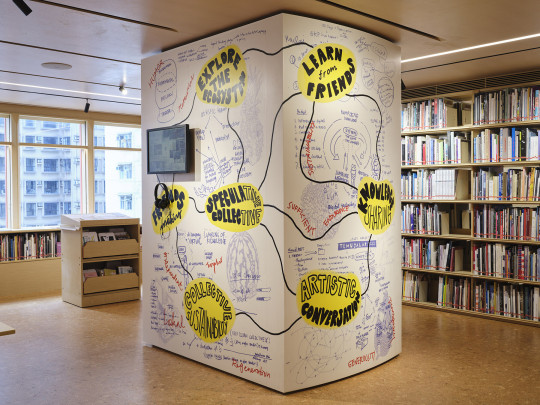
Gudskul, Temu Wall, 2022. Wall graphic with Gudskul, Veranda Talk, video. Installation view, “The Collective School,” CCG Library, Asia Art Archive, October 3, 2022–April 1, 2023. Photo: South Ho.
Susanna Chung: After we invited Gudskul to collaborate on “The Collective School,” they asked us to contribute to their study program. We joined Batch 4, the program’s fourth year, to develop it together with Gudskul and the cohort. While Batch 1 to Batch 3 were held at Gudskul’s campus, where collectives lived and studied together, Batch 4 was held completely online due to the pandemic. Collectives emerge in response to their unique contexts, and while many of them share ideas on the sustainability of collectives and the creation of education platforms, they respond to their contexts with different artistic practices. Becoming more adaptive and responsive to current events, Gudskul engendered new possibilities by connecting beyond Indonesia. As part of this unprecedented Batch, we were able to share and learn about different contexts in which collectivity persists.
Through four seminars, we introduced AAA’s extensive research on art pedagogies in relation to the development of contemporary art across Asia. After sharing case studies from China, India, the Philippines, and Thailand, we invited each collective to focus on one historical collective that most resonated. 2 Those who shared similar interests formed a group, which our researchers joined to exchange ideas, answer questions, and provide materials to inspire the collectives’ artworks. Our team crafted the exhibition narrative and display ideas only after all the works were finalized. All decisions were made in group discussions.
ÖE: The circular model of working diverges from our usual ways of organizing projects, which are often linear and entail a clear division of work. It’s refreshing. I would like to highlight an artwork here: In the middle of the library, we have a one-meter-high fire sculpture made by Quezon City–based collective Load na Dito. It is placed on top of a table covered with the reproduction of a black-and-white photograph depicting a burning action by Xiamen Dada, an art collective known for their radical performances critiquing art institutions in China in the late 1980s. This sculpture is further juxtaposed with a video documentary showing the creation of a four-meter-high effigy for a street demonstration by a group of collectives from Quezon City. Here, Load na Dito proposes the act of burning as a symbol of change and regeneration, a metaphor of collective actions that challenge institutions. By showing their connections with other collectives—both past and present—Load na Dito pays tribute to the legacy of activism of collectives and carries the torch forward.
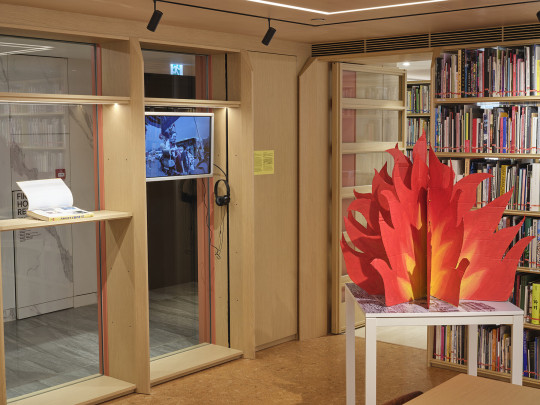
Load na Dito, Mad in Malacañang, 2022. Video, sculpture, and acrylic on cardboard. Installation view, “The Collective School,” CCG Library, Asia Art Archive, October 3, 2022–April 1, 2023. Photo: South Ho.
SC: Another compelling contribution is one between Pangrok Sulap and Salikhain Kolektib. They both responded to Womanifesto, a feminist art collective and biennial program in Thailand that was most active from the mid-1990s to the mid-2000s.
Pangrok Sulap uses woodcut print as their medium to empower rural communities. Depicting key moments in Womanifesto’s history, their work illustrates the solidarity among women artists and local craftspeople, prompting reflections about the role of artists as custodians of traditional cultural knowledge.
Salikhain Kolektib arranges archival materials about Womanifesto and their own collective chronologically. In the spirit of collaboration, Salikhain Kolektib joined Pangrok Sulap in creating a mirror display box. The mirroring effect melds the two collectives’ works in a fascinating way: the reverse of Pangrok Sulap’s print, featuring a protest for gender equality, can only be seen through Salikhain Kolektib’s artwork. Conversely, the partial reflections of materials through angled mirror slabs disrupt the chronological timeline of the latter’s installation. Rejecting the linearity and singularity of time and place, both collectives’ works invite us to think about sustainability, adaptability, and survival—common foundational concerns of contemporary art collectives.
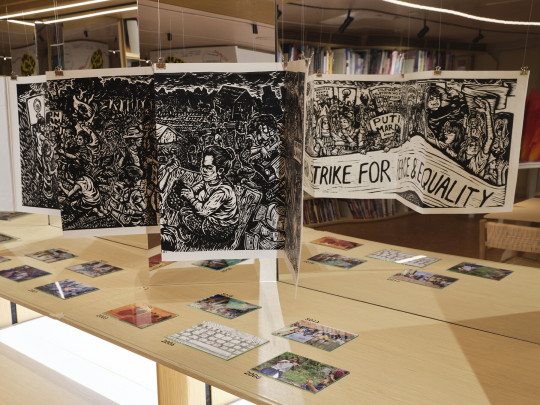
Salikhain Kolektib, Manifesting (In)constancy, 2022. Mixed-media installation; Pangrok Sulap, The Flower of the Nation, 2022. Woodblock print book. Installation view, “The Collective School,” CCG Library, Asia Art Archive, October 3, 2022–April 1, 2023. Photo: South Ho.
ÖE: It’s crucial that Gudskul, Batch 4, and our team discussed not only the potentials of working together but also the challenges and even limitations.
ba-bau AIR created an interactive jenga installation that materializes these conditions. Each hardwood block features terms from three texts related to Black Artists of Asia, a collective that initiated VIVA ExCon in the early 1990s. VIVA ExCon is the longest-running artist-led biennial in the Philippines, and this is another example of a contemporary collective revisiting art-historical documents and art actions in the region from the 1980s and 1990s.
As you begin building with the blocks, free associative readings about resilience and survival emerge. However, a jenga tower will eventually collapse, pointing to the tensions between construction and deconstruction. Yet when we think about the work not as a competition but as a cooperative game, the results become less finite. Your collective work might sometimes feel unstable, but the intention is to keep building together. Even if or when it collapses, other chances of regeneration will emerge.
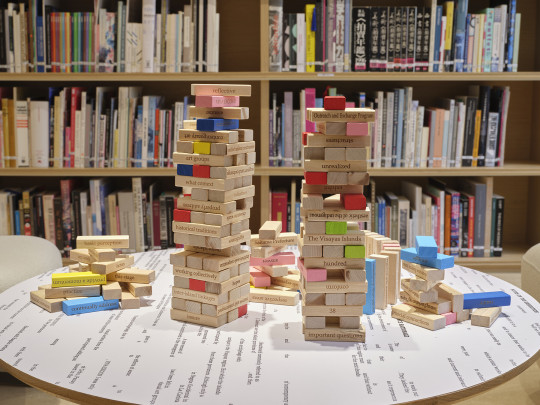
ba-bau AIR, Building a VIVA ExCon, 2022. Wood blocks. Installation view, “The Collective School,” CCG Library, Asia Art Archive, October 3, 2022–April 1, 2023. Photo: South Ho.
SC: The fluidity of art collectives, as showcased by ���The Collective School,” inspires the work we do. An archive is a mobile being, constantly rethinking its positioning and priorities through connecting with artists and collectives.
Their ideas shape our research, programs, and the sites we inhabit. “The Collective School,” for instance, has made us reflect on our long-term interest in pedagogy as a site where modern and contemporary art histories of the region have been written. Beyond the role of art school, this project has also encouraged us to generate new questions about artist-led models of education and alternative pedagogies. Apart from learning in schools, artists also learn from their peers. Collectives can serve as a continuous learning platform for those who have completed art school, as well as those who have not attended art school.
ÖE: One important takeaway from this exploration of how art collectives learn and educate is their insistence on play. It has inspired new programs, such as “Assemblage at AAA,” a durational performance by Hong Kong–based collective Floating Projects. For two days in a row, members brought in found materials as well as items from our library and office and from their own space, and began creating.
I immediately think back to a conversation with Floating Projects, where member Wong Chun-hoi said, “We should be in the same space and play together, instead of talking about what we do and how we do it.”
In the performance, the space of the archive was activated by sharing and collective action. One artist assembled a chess-like game, another few built a sculpture with shredded paper of the collective’s confidential documents, while some others made music and did automatic writing. Anyone in the library was invited to join.
SC: This collective model of learning also helped me rethink our educator programs. Since 2013, we have been organizing the annual Teaching Labs, a professional development series for teachers, each year focusing on a theme that is relevant to contemporary art and education, with this year’s being art collectives.
Working with Gudskul taught me that “art collectives” is not simply a “theme” for study but a model of learning. It inspired me to experiment with a new program, “Knowledge Kitchen,” where ten artists and ten educators gather for six hours each month to engage with creative exercises, games, chats, dinners, and sharing sessions by guest artists. We would like to use this process to practice and experiment with new models of learning. Our goal is to explore how teachers and artists can co-learn, co-create, and co-work together.
Arts programming, like formal education, often transmits knowledge one way; artists or teachers unilaterally impart their knowledge and experience to an audience. This program seeks to cultivate a more open and equal environment for knowledge exchange. We want to link artists’ unique abilities to interpret the world with educators’ intimate understanding of classroom settings. It’s exciting to see what comes out of this. Who knows? Maybe self-organized collaborative projects, lifelong friendships, and more. Our hope is that through this exploration, teachers and artists will reconsider their relationships with students and audiences in various educational and artistic settings, and engage with new imaginations for the future.
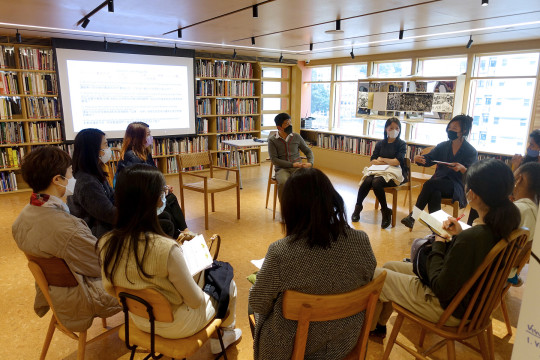
“Teaching Lab: Art between the Individual and the Collective,” Asia Art Archive, February 18, 2023. Courtesy of Asia Art Archive.
ÖE: Yes, we hope to move away from hierarchical ways of knowledge sharing. Apart from “Assemblage at AAA” and “Knowledge Kitchen,” we also hosted a live-streamed cooperative board game called “Speculative Collective.” Rather than inviting Gudskul and the eight collectives to present a talk, we asked them to show us what they cared about through playing. By responding to a series of challenge cards and drafting solutions, they revealed how they approach resource-sharing and collective decision-making. We wanted our audience to engage with—not to be told about—the exhibition.
SC: It’s important to us that this exhibition is the inaugural one of our newly renovated library. We have built a reading room in the center of the library, creating a space for co-working and co-learning, which also serves as a social space for discussion and learning from one another. Working with art collectives across Asia has not only helped us reorient the direction of our programming but has also allowed us to see the necessity and urgency of collectivity here in Hong Kong. We’ve deepened ties with our local partners Floating Projects and Rooftop Institute, whose practices revolve around alternative learning models. This is our first time studying the topic of collectives so closely, and the new library reflects who we are in the spatial sense. Since the beginning, we did not want the library to be a static collection, but rather a place to open up discussion. The study of collectives has made us realize that we share many values with Gudskul, such as learning from friends, engaging in artistic conversations, sharing knowledge, exploring the ecosystem, caring about sustainability, being speculative, and making friends, which are all essential for archive building.
A series of programs at the library resulted from organic discussions with these collectives. In particular, Hong Kong Conversations brought together different generations of artists and cultural workers to discuss historical and contemporary conditions that make collective work necessary in the city. The first talk gathered members from eight Hong Kong collectives founded in the 1990s—Southern Artists Salon, Green Wave Art, The Originals, Epical Chamber, NUX, Community Museum Project, Your Ears Covered, and Kultkuli—followed by three younger collectives—Black Window, Floating Projects, and Popo-Post Art Group. For me, it was a historical moment to see different generations of collectives in the same room, listening to and learning from each other.
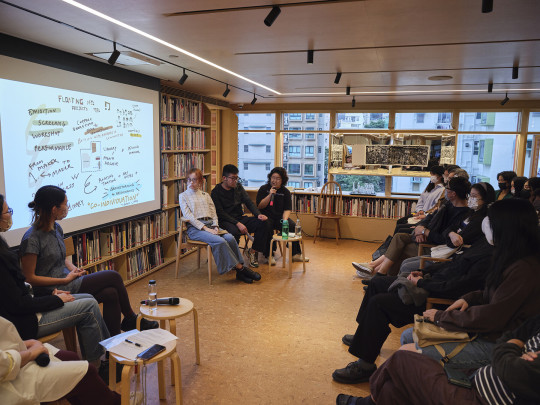
“Hong Kong Conversations 2022: The Collective School,” Asia Art Archive, November 26, 2022. Photo: South Ho.
ÖE: “The Collective School” is an example of how we see archives as social spaces to bring people together, to exchange knowledge, and to connect regional and local contexts. Some consider archives depositories that do not have to interpret or display their holdings. For us, artistic collaborations, including the ones developed from “The Collective School,” are crucial to challenge this view.
Our collaboration with Gudskul and eight other collectives taught me to insist on using exhibitions and programs as research as well as pedagogical tools. The project rearticulates our understanding of art history, one that prioritizes relationships and communities over individuals and singular artworks.
As part of “Assemblage at AAA,” here is an excerpt from the automatic writing of Linda Lai from Floating Projects: “A fresh new library surrounded by chaos and calm before a tempest. Free conversations absolutely free and automatic and without a frame from a handful of frames and many breakable frames.” 3 This is how I would like to imagine our library—a site for artistic intervention and knowledge via the engendering of fragments, play, and free associations, whether they are verbal, sculptural, or textual.
Notes
1. We are also grateful to our local Hong Kong partners Floating Projects and Rooftop Institute.
2. The case studies include the Stars Art Group, Xiamen Dada, and the New Measurement Group in China; Autonomous Women’s Movement in India; Black Artists of Asia in the Philippines; and Womanifesto in Thailand.
3 See →.
2 notes
·
View notes
Text




TRUSTED VETERINARY CLINICS AND VETERINARIAN DOCTORS IN QUEZON PROVINCE RECOMMENDED BY SIR KEN
📍 Quezon Province, Philippines
⚠️ Please take a moment to read this carefully. This is a humble recommendation based on the trust and confidence built by Sir Ken with these veterinarians over the past five years. Their exceptional service and dedication have greatly helped both his personal fur babies and the rescue cats and dogs under Cats of Quezon Province (CoQP).
When Cats of Quezon Province started in 2020, the organization was just beginning to establish itself and not many people were familiar with its advocacy work. Even at that early stage, these veterinarians provided their full support, offering quality care to CoQP’s rescues and Sir Ken’s personal pets 💛
DOCTOR ERNEST DOMINGO
Domingo Veterinary Clinic
📍Pearl Street, West Employees Village, Brgy, Gulang-Gulang, Lucena City, Quezon Province
Doc Domingo has been a cornerstone in caring for CoQP’s rescue animals both cats and dogs. For over five years, he has provided consistent and reliable support to the organization. Beyond his work with the rescues, Sir Ken has entrusted him with his own fur babies, knowing they are in capable hands. If you are looking for a dependable and experienced veterinarian in Lucena City, we can confidently recommend Doc Domingo for the care of your pets.
DOCTOR JAN "JV" VINCENT DEVANADERA
Jvetserv Veterinary Clinic Lucena
📍Kabukiran, Brgy. Gulang-Gulang, Lucena City, Quezon Province
Doc JV was one of the first veterinarians to support CoQP’s Kapon (spay/neuter) program. Over the years, his expertise and dedication to the rescue cats have built a strong foundation of trust. Sir Ken, impressed by Doc JV’s exceptional work, also entrusted him with his personal fur babies. With over five years of consistent care and outstanding results, JVetSet Veterinary Clinic stands out as one of the most trusted clinics in Lucena City that we are confident to recommend to everyone.
DOCTOR SHELLE GARCIA & DOCTOR GEN TUZON DE ARCE
Garcia Veterinary Clinic and Grooming Center
📍2B Cornerstone Bldg, Brgy. Bukal Pagbilao Quezon
Doc Shelle Garcia was instrumental in supporting CoQP’s Kapon Program during its early days. Her genuine care and dedication made her one of Sir Ken’s trusted veterinarians for both CoQP rescues and personal pets.
When Doc Shelle moved to Australia, Doc Gen Tuzon de Arce took over the clinic’s operations. Initially hesitant to trust a new vet, Sir Ken was reassured by the excellent care provided by Doc Gen. One of his fur babies, Shaun, embarrassed and recovered successfully under Doc Gen’s treatment after years of searching for a solution. Since then, Doc Gen has earned Sir Ken’s complete trust and continues to care for his personal pets and CoQP rescue with utmost professionalism.
Many people often ask us for recommendations, and these are the clinics and veterinarians we can wholeheartedly endorse. This trust is not based on sponsorships or financial incentives but rather on their proven track record of professionalism and compassionate care for their patients. These veterinarians have been trusted by Sir Ken even before Cats of Quezon Province gained recognition and their dedication has never wavered.
For nearly five years, these are the only clinics and veterinarians Sir Ken has relied on for both CoQP rescue animals and personal fur babies. We hope they can provide the same quality care and peace of mind for you and your beloved pets.
#DomingoVeterinaryClinic#JvetservVeterinaryClinic#GarciaVeterinaryClinic#CatsOfQuezonProvince#CoQP#CoQPTheStoryOfUs#SlowDownForPaws#PetsAreNotGifts#NoPetsLeftBehind#KaponAngSagotHindiPound#AdoptToSaveAndChangeTheirLives#AdoptPuspinsToSaveAndChangeTheirLives#KaponAngSolusyonParaPopulasyonNgPuspinAyMakontrol#SponsorAKaponAndSavePuspinLives#Cat#Cats#Dog#Dogs#Puspin#Puspins#Aspin#Aspins#CatLovers#DogLovers#AdoptACat#AdoptADog#AdoptAPuspin#AdoptAAspin#CatsOfPH#DogsOfPH
1 note
·
View note
Text
I'm Jason Tan Liwag, a film critic, curator, and lecturer based in Quezon City, Philippines.
Through my criticism and curatorial practice, I strive to examine the body and disability, the state and terror, and the ways the self can be severed from the collective and memory. My writing can be found in local publications such as CNN Philippines Life, Rappler, Inquirer Lifestyle, YoungSTAR, Vogue Philippines, and Rolling Stone Philippines, and international publications such as Filmmaker Magazine, MUBI Notebook, Little White Lies, Screen Slate, Ultradogme, MARG1N Magazine, Senses of Cinema, and Sentient Art Film.
I am an alumnus of film criticism programmes in Rotterdam, Udine, Yamagata, and Manila and am the founder and lead coordinator of the QCinema Critics Lab—a training ground for emerging Filipino film critics. I am the first Filipino member of FIPRESCI and a three-time international voter for the Golden Globe Awards and the Dorian Awards.
Presently, I am head of short film programming at the QCinema International Film Festival and also a short film programmer for the Leeds International Film Festival, with a special focus on Southeast Asian works and queer-centered short films. Most recently, I became co-curator of the Philippine lineup for S-Express with Oggs Cruz and program coordinator for the iNDIEGENIUS project lab.
Outside of cinema, he is a part-time multimedia arts and film lecturer at the CIIT College of Arts and Technology and iACADEMY.
Email me at [email protected].
1 note
·
View note
Text
Manila's Job Market Explodes: Top Companies Offering 6-Figure Salaries for Remote Workers!
A remarkable shift is reshaping Manila's employment landscape as we enter 2025. Major corporations and innovative startups are aggressively expanding their workforce, with an unprecedented focus on remote positions that offer salaries previously reserved for executive-level roles.
The job hiring scene in Metro Manila has reached a fever pitch, with multinational companies establishing strong footholds in the region. These organizations aren't just seeking talent – they're competing for it, driving salaries and benefits to new heights. Recent market analysis shows a 40% increase in positions offering compensation packages exceeding ₱80,000 monthly.
Work from home jobs in Manila have become the new gold standard, with companies recognizing that remote work isn't just a temporary solution but a permanent evolution in how business operates. Technology firms are leading this charge, offering positions in software development, digital marketing, and project management that can be performed entirely from home.
The current surge in jobs in Manila spans multiple sectors, from finance to creative industries. What's particularly noteworthy is the emphasis on skill development and career progression. Companies are investing heavily in their remote workforce, providing advanced training programs, international certifications, and clear paths to promotion.
Manila's emergence as a remote work hub has caught the attention of global companies. These organizations are specifically targeting Filipino professionals known for their strong English skills, adaptability, and technical proficiency. The result is an influx of opportunities that combine competitive local benefits with international standards of compensation.
Professionals with experience in digital technologies are finding themselves particularly in demand. Companies are offering comprehensive packages that include not just attractive salaries but also stock options, health benefits extending to dependents, and substantial technology allowances for home office setups.
The transformation of Manila's job market has also led to interesting hybrid models. Companies are creating innovative work arrangements where employees can choose their work environment based on their preferences and role requirements. This flexibility has proven to be a major draw for top talent.
What makes this job market particularly exciting is the democratization of opportunities. Whether you're a fresh graduate in Quezon City or an experienced professional in Makati, geographic location within Metro Manila no longer limits your career prospects. Remote work has leveled the playing field, allowing talent to shine regardless of location.
For job seekers looking to capitalize on these opportunities, the key is to position yourself effectively. Focus on developing digital skills, building a strong online portfolio, and highlighting any experience with remote collaboration tools. Companies are particularly interested in candidates who demonstrate initiative and self-management abilities.
The time to act is now. With companies actively recruiting and offering unprecedented packages, the current job market presents a unique opportunity for career advancement. Whether you're seeking a career change or looking to climb the corporate ladder, Manila's job market is ripe with possibilities.
Visit our job portal today to explore thousands of verified remote and hybrid positions across Metro Manila. Our platform features real-time job alerts, direct application systems, and dedicated support to help you land your dream role.
0 notes
Text

Article 90. The provisions on co-ownership shall apply to the absolute community of property between the spouses in all matters not provided for in this Chapter. (n) The law provides for the property regime in case of common law relationships or void marriages. (See Arts. 147 and 148, Family Code). In fact, the Supreme Court in Valdez vs. RTC of Quezon City, et al., G.R. No. 122749, July 31, 1996, 72 SCAD 967, said that the property relationship in void marriages ab initio is co-ownership and if ever there is a declaration of nullity of a void marriage, even if based on psychological incapacity, the dissolution of the properties or distribution shall be based on the law on co-ownership where the parties shall share and share alike.
0 notes